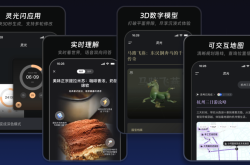Jack Ma Oversees as Alibaba Introduces Another New AI Contender
![]() 11/25 2025
11/25 2025
![]() 574
574

Recently, Ant Group's AI offering, 'Lingguang,' has garnered significant attention.
Official data indicates that Lingguang surpassed 1 million downloads within a mere 4 days of its launch, soaring to sixth place on the App Store China's free app chart. Its pace in achieving the first million downloads outstrips that of global mainstream AI products like ChatGPT, Sora2, and DeepSeek.
On the day of Lingguang's debut, Alibaba's founder, Jack Ma, also made an appearance at the Ant campus. Ant Group's CTO, He Zhengyu, disclosed in a media interview that Ma expressed keen interest in Lingguang's Key Performance Indicators (KPIs): "The initial target was set at 200,000 downloads, but Mr. Ma deemed it too modest and encouraged us to 'set our sights higher.'"
While this might appear to be a routine product launch, it actually marks a pivotal moment for observing Ant Group's strategic direction. With the growth of its financial business plateauing and AI becoming an essential component for all tech giants, Lingguang's introduction is far from impulsive.
It raises two fundamental questions that Ant must address: How robust is its technological prowess? And where will its future growth momentum originate?
I. Product Experience: Noteworthy, Yet Not Groundbreaking
Lingguang is not integrated into Alipay but is instead presented as a standalone app. This decision itself reflects Ant's ambition to establish a pure AI platform, unburdened by payment-related constraints.
The product interface is designed for simplicity, featuring a central dialogue box that encourages direct interaction between users and the AI.
The three initial core functions largely define Lingguang's capabilities.
'Lingguang Dialogue' serves as the foundational feature, extending beyond simple text-based queries and responses. Its standout feature is its support for full-modal information output, including 3D digital models, audio, and icons. Unlike applications such as ChatGPT, Yuanbao, or Doubao, which typically provide lengthy text blocks as answers—potentially overwhelming for those with an aesthetic inclination—Lingguang's responses are more refined, often accompanied by images and charts.
For instance, if you inquire, "What are some famous mountains in China?" Lingguang will display images like Huangshan's Welcome Pine and present a comparative table of the altitudes of the 'Five Sacred Mountains.' This multidimensional information presentation is indeed more intuitive and user-friendly than plain text chat.
'Lingguang Flash Apps' might currently be the most distinctive function, aiming to achieve 'natural language-based 30-second app generation' on mobile devices, enabling 'on-the-fly app creation.' For example, if you request, "Create an app for deciding what to eat tomorrow," it can generate a random draw lottery mini-program to assist those with decision-making difficulties in choosing their meals. The potential here is immense—it seeks to democratize app development capabilities from programmers to every ordinary user.
'Lingguang Vision' allows users to point their phone cameras at objects, scenes, or text, providing real-time identification and detailed information. For instance, it can identify plant species, product brands and models, and architectural styles, while also explaining their characteristics, uses, or related knowledge. Additionally, it can expand and extend knowledge. For example, taking a photo of a dish can provide its recipe and nutritional information.
However, when placed in the fiercely competitive AI application market, Lingguang appears somewhat cautious and lacks a truly groundbreaking edge.
Among its core functions, while 'Lingguang Dialogue' emphasizes aesthetically pleasing answer formatting with images and tables, its conversational interaction fluidity and depth of thinking remain relatively average compared to mature products like ChatGPT, DeepSeek, and Claude. The accuracy of 'Lingguang Vision's' object recognition and information extension functions also has room for improvement in practical use, failing to demonstrate sufficiently differentiated 'unique selling points.'
The most distinctive 'Flash Apps' offer hope for a breakthrough, but whether it can continuously attract a large number of ordinary users remains to be seen over time. A core challenge lies in the fact that most of the various apps it generates already have well-established, highly mature standalone counterparts in the market, which are often richer and more powerful.
Currently, the biggest selling point of 'Flash Apps' is extreme 'personalization'—customizable with just a casual remark. However, whether this 'personalization' convenience can shake users' reliance on 'functional' completeness remains uncertain.
Overall, Lingguang reflects Ant's technological exploration, but to transition from having noteworthy features to truly impressing users, it needs to find more solid and universal footholds. While the product is now on display, the strategic calculations behind it are even more worthy of close examination.
II. Behind Lingguang: Ant Group's New Growth Narrative
For Ant Group, launching Lingguang is not a choice but a necessity driven by internal and external trends.
Firstly, it is a move to reinforce its technological identity. Historically, the 'finance' label brought Ant Group immense success but also limited its imagination. Changes in the regulatory environment and slowing business growth have compelled it to craft a new narrative. In this era, what better represents 'technology' than AI?
He Zhengyu revealed that the explosive popularity of DeepSeek earlier this year brought excitement but also urgency and even a sense of 'embarrassment' within Ant Group. On the first day back after the holiday, they convened for three days of meetings, made strategic choices, and formed a relatively independent AGI team internally in March.
Lingguang's launch, particularly its demonstration of full-modal generation and app development capabilities, represents Ant Group's latest foray into the AI field. It aims to prove that its technological foundation is robust enough to support its transformation into a true tech company in the AI era, a crucial step in shedding its label constraints and expanding its development space.
Secondly, it is a key step in ecological supplementation. As a national-level application, Alipay excels in 'efficiency' and 'trust,' but its shortcomings lie in 'retention' and 'extension.'
When we open Alipay, our objectives are usually clear: making payments, transferring funds, or paying bills. Once accomplished, we typically exit. This 'strong tool, weak content' attribute is a significant drawback in today's competition for user time. Although Alipay has been ramping up content in recent years, such as introducing short videos to increase user retention, many still perceive it as a 'use-and-go' tool.
Future competition will not just revolve around traffic but also user time and mindshare. From DeepSeek's deep thinking going viral to ByteDance's Doubao, and Alibaba's continuous adjustments in its AI-to-Consumer (AI to C) strategy—from Tongyi to Kuake and Qianwen—Chinese internet giants are all betting on AI to C entry points. However, the industry has yet to witness an AI product with over 100 million daily active users.
Currently, Ant Group hopes to establish a scenario where users can 'linger' and naturally extend to more services. Lingguang's standalone app form and its exploration of scenarios like office work, creativity, and information acquisition may serve this purpose. It attempts to create another 'productivity and cognitive entry point' beyond Alipay's transactional entry, a long-term layout for its ecological defense and expansion.
Thirdly, it is Ant Group's exploration of future boundaries. Ant Group's future growth cannot be confined to the financial sector alone. It must explore broader service spaces. However, directly integrating these new scenarios into Alipay would seem out of place and even disrupt its original core experience.
From Ant Group's perspective, it must have a representative product of its own in the AGI era. It could be AQ, Maxiaocai, or Lingguang. Their goal is to create a national-level application. Given that AGI currently offers vast technological and market space, filled with uncertainties, their strategic logic resembles searching for water in a desert: 'We definitely won't send everyone in one direction.'
Currently, Lingguang has become a suitable experimental field. Here, Ant Group can test user demand for low-code development at a relatively low cost through 'Flash Apps' and test the market potential of information services through 'Vision.' Which features can address pain points and which scenarios have commercialization potential can be verified here.
Therefore, while Lingguang may seem like just a product, it actually carries Ant Group's triple ambitions of reshaping its image, supplementing its ecological shortcomings, and exploring future boundaries.
The strategic blueprint has been laid out, but the path to the future is never smooth. Several major hurdles lie ahead for Ant Group's Lingguang.
III. Three Major Hurdles to Overcome Before Success
Ideals are often ambitious, but reality tends to be challenging. Lingguang's journey was destined to be a tough battle from the moment it set out, facing at least three major hurdles ahead.
The first hurdle is the fierce competition in the external red ocean. The current AI application landscape can no longer be described as crowded; the functionalities of products from tech giants and startups are rapidly converging. A large number of AI applications, including DeepSeek, Doubao, Kimi, and Wenxin Yiyan, are all vying for user entry points.
While Lingguang takes pride in its 'Flash Apps' functionality, which is indeed novel, it faces significant costs in educating user habits. Among numerous choices, will users be willing to use a dedicated app just for the need to 'generate mini-programs'? It must quickly prove that the convenience brought by its functional integration can overcome users' inertia in switching between different apps. Otherwise, it risks falling into a situation of heavy investment with little response.
The second hurdle is internal system synergy and competition. Within the Alibaba ecosystem, the AI product lineup already appears somewhat crowded. 'Qianwen,' launched almost simultaneously with Lingguang, is regarded by Alibaba as a C-end AI product in full competition with ChatGPT. Previously, Kuake was also seen by Alibaba as an important strategy in the AI to C field, positioned as an AI flagship application and intelligent search entry point.
Now, with Ant Group launching Lingguang, how to achieve clear market positioning and user diversion among the three, avoiding 'internal competition' and resource wastage, presents an extremely complex internal challenge.
If even internally, this 'sibling competition' cannot be resolved, the market will only receive mixed and unclear signals. This tests the strategic resolve and coordination wisdom of Ant Group and even the entire Alibaba ecosystem's senior leadership.
The third hurdle is crossing the 'cognitive gap' of user habits, a fundamental challenge faced by all new products.
While Lingguang's three core functions and full-modal output seem comprehensive, upon closer inspection, users' existing needs are already met by mature products: complex tasks can be handled on computers with professional software, while temporary queries can be done using AI search within WeChat. Why should users change their deeply ingrained habits formed over years to download and use a brand-new app?
How can Lingguang persuade users to integrate these scattered needs into a cohesive experience within Lingguang and form a dependency on frequent use? Transitioning from 'having a product' to 'being used by someone' and then to 'being loved by someone' is a hurdle that Lingguang must overcome, yet it is also the most difficult one.
In the AI journey, which is destined to be long, Ant Group has unveiled a distinctive weapon, but the most brutal battle has only just begun.








